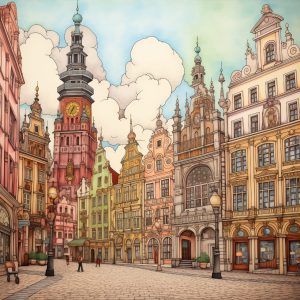Coloring pages have long been a cherished pastime in many cultures, and Poland is no exception. The history of coloring pages in Poland reflects the nation’s rich artistic traditions and its evolving engagement with both educational and recreational activities for children and adults. This journey spans from traditional folk art to modern-day digital coloring, showcasing a blend of cultural heritage and contemporary creativity.

Early Beginnings: Folk Art and Traditions
The origins of coloring in Poland can be traced back to the country’s rich tradition of folk art. Traditional Polish folk art, known for its vibrant colors and intricate patterns, served as an early inspiration for coloring activities. One of the most prominent forms of this art is Wycinanki, a traditional Polish paper cutting art. These designs, featuring symmetrical patterns of flowers, animals, and rural scenes, provided a natural template for coloring.
Another significant influence came from the famous Bolesławiec pottery, known for its distinctive blue and white designs. These intricate patterns also lent themselves well to coloring, allowing people to recreate the traditional motifs in their own style.
The Rise of Printed Coloring Books
The concept of printed coloring books began to gain popularity in Poland during the early 20th century. These books were initially educational tools, designed to help children learn through engaging activities. They often featured simple illustrations of the alphabet, numbers, and everyday objects, making learning more interactive and enjoyable for young children.
Post-World War II Poland saw a surge in the production of coloring books as the country focused on rebuilding and modernizing its educational system. Coloring books became widely available and were used in schools and homes to aid in the development of fine motor skills, creativity, and knowledge retention among children.
Coloring Pages in the Socialist Era
During the socialist era in Poland, coloring books were not just educational tools but also vehicles for ideological education. Many coloring books from this period contained themes promoting socialist values, patriotism, and collective work. They often depicted scenes of everyday life in a socialist society, agricultural work, and industrial achievements.
Despite the political undertones, these coloring books continued to serve as an important creative outlet for children. They allowed young minds to engage with art and storytelling, fostering a sense of imagination and artistic expression.
Modern Trends and Digital Revolution
The fall of communism in Poland brought about significant cultural and economic changes, including a boom in consumer goods and creative industries. The 1990s and 2000s saw a diversification of themes in coloring books, ranging from fairy tales and fantasy worlds to educational topics and popular media franchises.
The advent of the digital age revolutionized the world of coloring pages. Digital coloring apps and online platforms became increasingly popular, offering interactive experiences that traditional coloring books could not provide. These digital tools allowed users to access a vast array of designs and colors at their fingertips, making coloring more accessible and versatile.
The Therapeutic and Educational Benefits
In contemporary Poland, coloring pages are recognized for their therapeutic and educational benefits. The practice of coloring has been embraced as a form of mindfulness and stress relief, not just for children but also for adults. Adult coloring books, featuring intricate designs and complex patterns, have gained popularity as a relaxing and creative hobby.
Educational institutions continue to use coloring pages as valuable teaching aids. They help in teaching various subjects, from language and mathematics to history and science, in an engaging and interactive manner. Coloring activities are also used to support the development of fine motor skills, concentration, and artistic abilities in children.
Conclusion
The history of coloring pages in Poland is a testament to the enduring appeal and versatility of this simple yet profound activity. From its roots in traditional folk art to its evolution into modern digital formats, coloring has played a significant role in Polish culture and education. It has provided generations of children and adults with a creative outlet, a tool for learning, and a source of comfort and joy. As technology continues to advance, the future of coloring pages in Poland promises to be as vibrant and dynamic as its past.